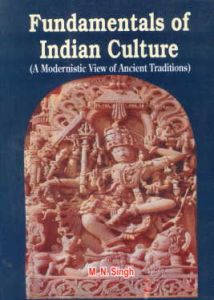
Contents: Preface. 1. Vedas. 2. Varnashram Dharma. 3. Hindu Samskara. 4. Purushartha : Goals of human pursuit. 5. Doctrine of Avatara. 6. Sagaramanthan : Churninco of ocean mythology. 7. Pilgrimage Tirthyatra. 8. Panchayatana : worship of five deities. 9. Idol worship and erotica in temples. 10. Principal Hindu deities. Appendices.
"Indian culture has been Veda centric. It was, therefore considered necessary to make a rapid survey of what constitutes the Veda in the beginning.
Vedas are the oldest literature of the world. They are the holy books of the Hindus and are the foundation of Hindu religion (Vedo akhilo dharma mulam) and such the chief object of the nation's greatest reverence and admiration. They have been so thoroughly and religiously preserved that despite their huge bulk and elapse of thousands of years since their codification not a single variation in the reading has been detected. No country has taken care so meticulously and tediously to preserve its heritage as the Hindus.
In the 2nd chapter dealing with Varnashrama Dharma, the distinction between Varna and Jati which are loosely translated by caste has been clearly brought out. In the Varna theory we have the blue print for an ideal social organization. Caste system symbolizes an attempt to institutionalize that ideal. Like many other ideals, Varna ideal was based on sound psychological principles. But when it was put into actual practice the lofty ideal gradually became blurred and the caste system was reduced to a caricature of the noble principles of Verna ideal and the laudable ideal of mutual cooperation was transformed into mutual recrimination. Economic interests of different sections of the society brought forth all the evils of the caste system. Varna system insisted on duties (dharma). But over the times privileged sections laid emphasis on their rights ignoring their duties.
This chapter also deals with the relationship between gotra and totem. It is commonly believed that members of a particular clan (gotra) are descendants of a common ancestor, that mythetical common ancestor being an animal or a plant or a bird that invariably is the totem of the clan or family. Examples of similarity of gotra and totem names have also been explored in this chapter.......